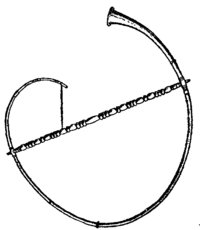
Buccina
Encyclopedia

- Bučina is the name of several locations in the Czech RepublicCzech RepublicThe Czech Republic is a landlocked country in Central Europe. The country is bordered by Poland to the northeast, Slovakia to the east, Austria to the south, and Germany to the west and northwest....
.
A buccina or bucina , anglicized buccin
Buccin
The buccin is a visually distinctive trombone popularized in military bands in France between 1810–1845 which subsequently faded into obscurity....
or bucine, is a brass instrument
Brass instrument
A brass instrument is a musical instrument whose sound is produced by sympathetic vibration of air in a tubular resonator in sympathy with the vibration of the player's lips...
used in the ancient Roman army similar to the Cornu
Cornu (horn)
A cornu or cornum was a type of brass instrument similar to the buccina used by the Roman army of antiquity mainly for communicating orders to troops in battle. It is a Latin word literally meaning horn. The instrument was about long and took the form of a letter 'G'...
. An aeneator
Aeneator
An aeneator refers to a classical Roman professional performer of a horn who was attached to a Roman miltiary unit. The word comes from Latin aēneus or ahēneus, "brazen", from aes, "copper alloy".-Aeneators' role in war:...
who blew a buccina was called a "buccinator" or "bucinator" .
It was originally designed as a tube measuring some 11 to 12 feet in length, of narrow cylindrical bore, and played by means of a cup-shaped mouthpiece
Mouthpiece (brass)
On brass instruments the mouthpiece is the part of the instrument which is placed upon the player's lips. The purpose of the mouthpiece is a resonator, which passes vibration from the lips to the column of air contained within the instrument, giving rise to the standing wave pattern of vibration in...
. The tube is bent round upon itself from the mouthpiece to the bell in the shape of a broad C and is strengthened by means of a bar across the curve, which the performer grasps while playing, in order to steady the instrument; the bell curves over his head or shoulder.
The buccina was used for the announcement of night watches and various other purposes in the camp.
The instrument is the ancestor of both the trumpet
Trumpet
The trumpet is the musical instrument with the highest register in the brass family. Trumpets are among the oldest musical instruments, dating back to at least 1500 BCE. They are played by blowing air through closed lips, producing a "buzzing" sound which starts a standing wave vibration in the air...
and the trombone
Trombone
The trombone is a musical instrument in the brass family. Like all brass instruments, sound is produced when the player’s vibrating lips cause the air column inside the instrument to vibrate...
. The German word for trombone, Posaune, is linguistically derived from Buccina.
In the final section of his orchestral work Pines of Rome
Pini di Roma
Pines of Rome is a symphonic poem written in 1924 by the Italian composer Ottorino Respighi and, together with Fontane di Roma and Feste Romane, forms what is sometimes loosely referred to as his "Roman trilogy"...
(The Roman Pines), Respighi
Ottorino Respighi
Ottorino Respighi was an Italian composer, musicologist and conductor. He is best known for his orchestral "Roman trilogy": Fountains of Rome ; Pines of Rome ; and Roman Festivals...
calls for six instruments of different ranges notated as "Buccine" (Italian plural), although he expected them to be played on modern saxhorn
Saxhorn
The saxhorn is a valved brass instrument with a conical bore and deep cup-shaped mouthpiece. The sound has a characteristic mellow quality, and blends well with other brass.-The saxhorn family:...
s or flugelhorn
Flugelhorn
The flugelhorn is a brass instrument resembling a trumpet but with a wider, conical bore. Some consider it to be a member of the saxhorn family developed by Adolphe Sax ; however, other historians assert that it derives from the valve bugle designed by Michael Saurle , Munich 1832 , thus...
s. Similarly, he also used these instruments in the opening movement of his Feste Romane
Feste Romane
Feste Romane is a work for very large symphony orchestra composed in 1926, by the Italian composer Ottorino Respighi. It is a tone poem depicting scenes from Ancient Rome of the Roman Empire...
(The Roman Festivals).
External links
- Buccina in Smith's Dictionary of Greek and Roman Antiquities.

